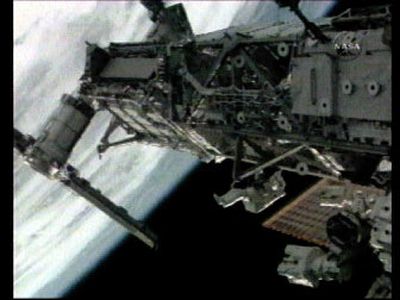Astronauts attach truss, solar arrays to space station

Astronauts from the shuttle Atlantis attached new hardware to the International Space Station on Tuesday and also inadvertently added to the floating garbage dump that surrounds the Earth when the two spacewalkers watched a bolt float away from their zero-gravity construction site.
“I just hope that bolt is on its way to mother Earth” and not in an orbit that could bring it back and hit the station, lamented astronaut Joe Tanner, who was trying to attach the bolt when it and a spring and washer jerked loose and drifted away.
Several thousand pieces of space junk orbit the Earth and are considered such a potential danger to spacecraft that the larger pieces of flotsam are constantly monitored, just like satellites.
NASA officials tried to assuage Tanner’s concern. “We have evaluated the risk and at this point we are not concerned about it,” said Kirk Shireman, a spokesman for the International Space Station.
The errant two-ounce bolt was the only glitch in an otherwise flawless performance by Tanner and his spacewalking teammate, Heidemarie Stefanyshyn-Piper, who spent more than six hours in space connecting a 17-ton truss and its attached solar arrays to the station. Altogether, they connected 13 wires and tubes and adjusted 167 bolts.
“It was an outstanding day on orbit; the berthing went exactly as planned,” Shireman said.
More good news came when the high-level Mission Management Team meeting at Johnson Space Center in Houston cleared Atlantis as safe to return to Earth next week. The clearance came after engineers spent 60 hours looking at film and radar images of the launch.
Only two potential problems cropped up: a protruding piece of plastic between two heat-resistant tiles and a piece of a thermal “blanket” sticking out near an engine used to adjust the spacecraft’s orbit. Neither issue will cause problems for re-entry, NASA said.
“Overall, Atlantis is performing extremely well,” said John Shannon, chair of the management team.
Installation of the truss, a piece of the station’s spine to which laboratories will be attached later, was the first construction work on the space station since the Columbia accident in 2003. The attached solar arrays, when operational, will double the amount of power the station can produce.
The arrays are scheduled to be unfurled to their full 240-foot-length on Thursday.